Jing Su
Multi-SWE-bench: A Multilingual Benchmark for Issue Resolving
Apr 03, 2025Abstract:The task of issue resolving is to modify a codebase to generate a patch that addresses a given issue. However, existing benchmarks, such as SWE-bench, focus almost exclusively on Python, making them insufficient for evaluating Large Language Models (LLMs) across diverse software ecosystems. To address this, we introduce a multilingual issue-resolving benchmark, called Multi-SWE-bench, covering Java, TypeScript, JavaScript, Go, Rust, C, and C++. It includes a total of 1,632 high-quality instances, which were carefully annotated from 2,456 candidates by 68 expert annotators, ensuring that the benchmark can provide an accurate and reliable evaluation. Based on Multi-SWE-bench, we evaluate a series of state-of-the-art models using three representative methods (Agentless, SWE-agent, and OpenHands) and present a comprehensive analysis with key empirical insights. In addition, we launch a Multi-SWE-RL open-source community, aimed at building large-scale reinforcement learning (RL) training datasets for issue-resolving tasks. As an initial contribution, we release a set of 4,723 well-structured instances spanning seven programming languages, laying a solid foundation for RL research in this domain. More importantly, we open-source our entire data production pipeline, along with detailed tutorials, encouraging the open-source community to continuously contribute and expand the dataset. We envision our Multi-SWE-bench and the ever-growing Multi-SWE-RL community as catalysts for advancing RL toward its full potential, bringing us one step closer to the dawn of AGI.
MAP-based Problem-Agnostic diffusion model for Inverse Problems
Jan 25, 2025



Abstract:Diffusion models have indeed shown great promise in solving inverse problems in image processing. In this paper, we propose a novel, problem-agnostic diffusion model called the maximum a posteriori (MAP)-based guided term estimation method for inverse problems. We divide the conditional score function into two terms according to Bayes' rule: the unconditional score function and the guided term. We design the MAP-based guided term estimation method, while the unconditional score function is approximated by an existing score network. To estimate the guided term, we base on the assumption that the space of clean natural images is inherently smooth, and introduce a MAP estimate of the $t$-th latent variable. We then substitute this estimation into the expression of the inverse problem and obtain the approximation of the guided term. We evaluate our method extensively on super-resolution, inpainting, and denoising tasks, and demonstrate comparable performance to DDRM, DMPS, DPS and $\Pi$GDM.
Each Rank Could be an Expert: Single-Ranked Mixture of Experts LoRA for Multi-Task Learning
Jan 25, 2025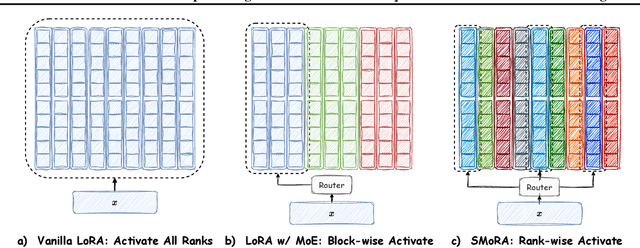
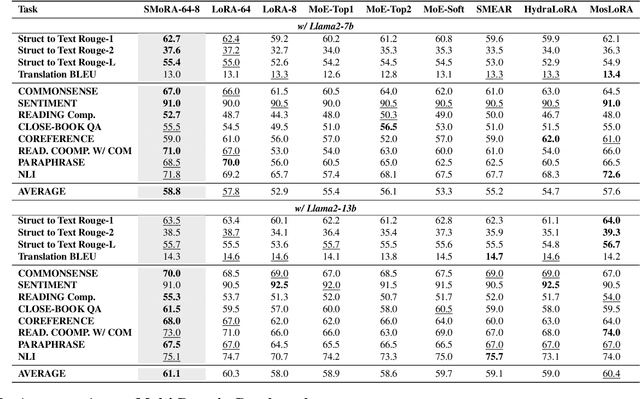
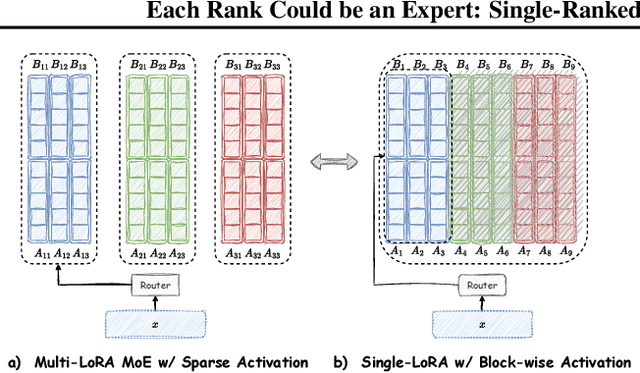
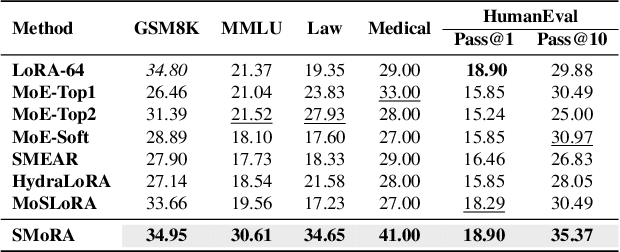
Abstract:Low-Rank Adaptation (LoRA) is widely used for adapting large language models (LLMs) to specific domains due to its efficiency and modularity. Meanwhile, vanilla LoRA struggles with task conflicts in multi-task scenarios. Recent works adopt Mixture of Experts (MoE) by treating each LoRA module as an expert, thereby mitigating task interference through multiple specialized LoRA modules. While effective, these methods often isolate knowledge within individual tasks, failing to fully exploit the shared knowledge across related tasks. In this paper, we establish a connection between single LoRA and multi-LoRA MoE, integrating them into a unified framework. We demonstrate that the dynamic routing of multiple LoRAs is functionally equivalent to rank partitioning and block-level activation within a single LoRA. We further empirically demonstrate that finer-grained LoRA partitioning, within the same total and activated parameter constraints, leads to better performance gains across heterogeneous tasks. Building on these findings, we propose Single-ranked Mixture of Experts LoRA (\textbf{SMoRA}), which embeds MoE into LoRA by \textit{treating each rank as an independent expert}. With a \textit{dynamic rank-wise activation} mechanism, SMoRA promotes finer-grained knowledge sharing while mitigating task conflicts. Experiments demonstrate that SMoRA activates fewer parameters yet achieves better performance in multi-task scenarios.
Interference-Robust Broadband Rapidly-Varying MIMO Communications: A Knowledge-Data Dual Driven Framework
Dec 26, 2024Abstract:A novel time-efficient framework is proposed for improving the robustness of a broadband multiple-input multiple-output (MIMO) system against unknown interference under rapidly-varying channels. A mean-squared error (MSE) minimization problem is formulated by optimizing the beamformers employed. Since the unknown interference statistics are the premise for solving the formulated problem, an interference statistics tracking (IST) module is first designed. The IST module exploits both the time- and spatial-domain correlations of the interference-plus-noise (IPN) covariance for the future predictions with data training. Compared to the conventional signal-free space sampling approach, the IST module can realize zero-pilot and low-latency estimation. Subsequently, an interference-resistant hybrid beamforming (IR-HBF) module is presented, which incorporates both the prior knowledge of the theoretical optimization method as well as the data-fed training. Taking advantage of the interpretable network structure, the IR-HBF module enables the simplified mapping from the interference statistics to the beamforming weights. The simulations are executed in high-mobility scenarios, where the numerical results unveil that: 1) the proposed IST module attains promising prediction accuracy compared to the conventional counterparts under different snapshot sampling errors; and 2) the proposed IR-HBF module achieves lower MSE with significantly reduced computational complexity.
The Rise and Down of Babel Tower: Investigating the Evolution Process of Multilingual Code Large Language Model
Dec 10, 2024



Abstract:Large language models (LLMs) have shown significant multilingual capabilities. However, the mechanisms underlying the development of these capabilities during pre-training are not well understood. In this paper, we use code LLMs as an experimental platform to explore the evolution of multilingual capabilities in LLMs during the pre-training process. Based on our observations, we propose the Babel Tower Hypothesis, which describes the entire process of LLMs acquiring new language capabilities. During the learning process, multiple languages initially share a single knowledge system dominated by the primary language and gradually develop language-specific knowledge systems. We then validate the above hypothesis by tracking the internal states of the LLMs through identifying working languages and language transferring neurons. Experimental results show that the internal state changes of the LLM are consistent with our Babel Tower Hypothesis. Building on these insights, we propose a novel method to construct an optimized pre-training corpus for multilingual code LLMs, which significantly outperforms LLMs trained on the original corpus. The proposed Babel Tower Hypothesis provides new insights into designing pre-training data distributions to achieve optimal multilingual capabilities in LLMs.
A Lightweight Target-Driven Network of Stereo Matching for Inland Waterways
Oct 10, 2024Abstract:Stereo matching for inland waterways is one of the key technologies for the autonomous navigation of Unmanned Surface Vehicles (USVs), which involves dividing the stereo images into reference images and target images for pixel-level matching. However, due to the challenges of the inland waterway environment, such as blurred textures, large spatial scales, and computational resource constraints of the USVs platform, the participation of geometric features from the target image is required for efficient target-driven matching. Based on this target-driven concept, we propose a lightweight target-driven stereo matching neural network, named LTNet. Specifically, a lightweight and efficient 4D cost volume, named the Geometry Target Volume (GTV), is designed to fully utilize the geometric information of target features by employing the shifted target features as the filtered feature volume. Subsequently, to address the substantial texture interference and object occlusions present in the waterway environment, a Left-Right Consistency Refinement (LRR) module is proposed. The \text{LRR} utilizes the pixel-level differences in left and right disparities to introduce soft constraints, thereby enhancing the accuracy of predictions during the intermediate stages of the network. Moreover, knowledge distillation is utilized to enhance the generalization capability of lightweight models on the USVInland dataset. Furthermore, a new large-scale benchmark, named Spring, is utilized to validate the applicability of LTNet across various scenarios. In experiments on the aforementioned two datasets, LTNet achieves competitive results, with only 3.7M parameters. The code is available at https://github.com/Open-YiQingZhou/LTNet .
FAN: Fourier Analysis Networks
Oct 03, 2024



Abstract:Despite the remarkable success achieved by neural networks, particularly those represented by MLP and Transformer, we reveal that they exhibit potential flaws in the modeling and reasoning of periodicity, i.e., they tend to memorize the periodic data rather than genuinely understanding the underlying principles of periodicity. However, periodicity is a crucial trait in various forms of reasoning and generalization, underpinning predictability across natural and engineered systems through recurring patterns in observations. In this paper, we propose FAN, a novel network architecture based on Fourier Analysis, which empowers the ability to efficiently model and reason about periodic phenomena. By introducing Fourier Series, the periodicity is naturally integrated into the structure and computational processes of the neural network, thus achieving a more accurate expression and prediction of periodic patterns. As a promising substitute to multi-layer perceptron (MLP), FAN can seamlessly replace MLP in various models with fewer parameters and FLOPs. Through extensive experiments, we demonstrate the effectiveness of FAN in modeling and reasoning about periodic functions, and the superiority and generalizability of FAN across a range of real-world tasks, including symbolic formula representation, time series forecasting, and language modeling.
BabelBench: An Omni Benchmark for Code-Driven Analysis of Multimodal and Multistructured Data
Oct 01, 2024



Abstract:Large language models (LLMs) have become increasingly pivotal across various domains, especially in handling complex data types. This includes structured data processing, as exemplified by ChartQA and ChatGPT-Ada, and multimodal unstructured data processing as seen in Visual Question Answering (VQA). These areas have attracted significant attention from both industry and academia. Despite this, there remains a lack of unified evaluation methodologies for these diverse data handling scenarios. In response, we introduce BabelBench, an innovative benchmark framework that evaluates the proficiency of LLMs in managing multimodal multistructured data with code execution. BabelBench incorporates a dataset comprising 247 meticulously curated problems that challenge the models with tasks in perception, commonsense reasoning, logical reasoning, and so on. Besides the basic capabilities of multimodal understanding, structured data processing as well as code generation, these tasks demand advanced capabilities in exploration, planning, reasoning and debugging. Our experimental findings on BabelBench indicate that even cutting-edge models like ChatGPT 4 exhibit substantial room for improvement. The insights derived from our comprehensive analysis offer valuable guidance for future research within the community. The benchmark data can be found at https://github.com/FFD8FFE/babelbench.
Merging LoRAs like Playing LEGO: Pushing the Modularity of LoRA to Extremes Through Rank-Wise Clustering
Sep 24, 2024
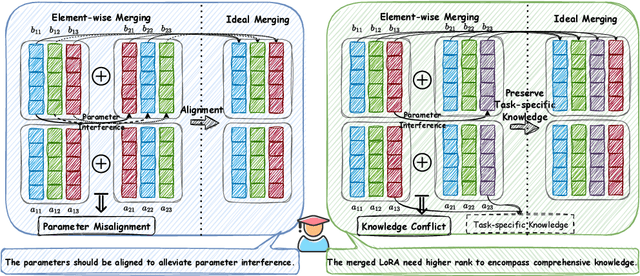
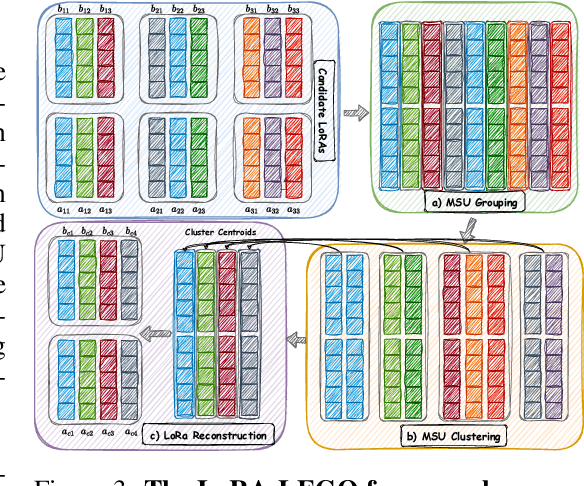
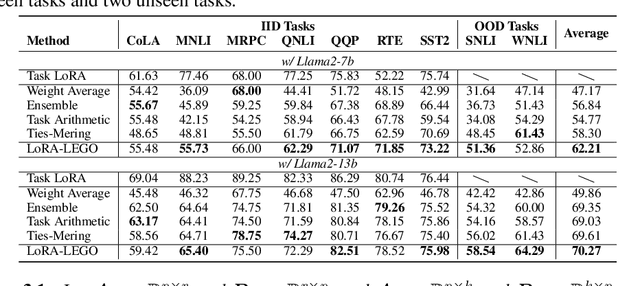
Abstract:Low-Rank Adaptation (LoRA) has emerged as a popular technique for fine-tuning large language models (LLMs) to various domains due to its modular design and widespread availability on platforms like Huggingface. This modularity has sparked interest in combining multiple LoRAs to enhance LLM capabilities. However, existing methods for LoRA composition primarily focus on task-specific adaptations that require additional training, and current model merging techniques often fail to fully leverage LoRA's modular nature, leading to parameter interference and performance degradation. In this paper, we investigate the feasibility of disassembling and reassembling multiple LoRAs at a finer granularity, analogous to assembling LEGO blocks. We introduce the concept of Minimal Semantic Units (MSUs), where the parameters corresponding to each rank in LoRA function as independent units. These MSUs demonstrate permutation invariance and concatenation-summation equivalence properties, enabling flexible combinations to create new LoRAs. Building on these insights, we propose the LoRA-LEGO framework. This framework conducts rank-wise parameter clustering by grouping MSUs from different LoRAs into $k$ clusters. The centroid of each cluster serves as a representative MSU, enabling the assembly of a merged LoRA with an adjusted rank of $k$. Additionally, we apply a dual reweighting strategy to optimize the scale of the merged LoRA. Experiments across various benchmarks demonstrate that our method outperforms existing approaches in LoRA merging.
An Expert is Worth One Token: Synergizing Multiple Expert LLMs as Generalist via Expert Token Routing
Mar 25, 2024
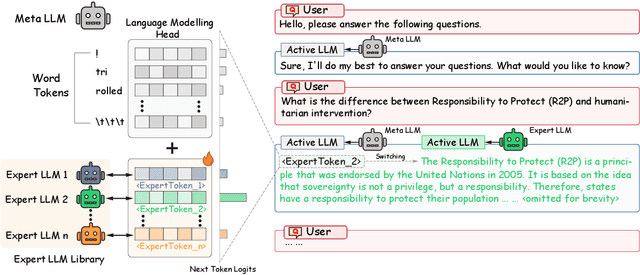
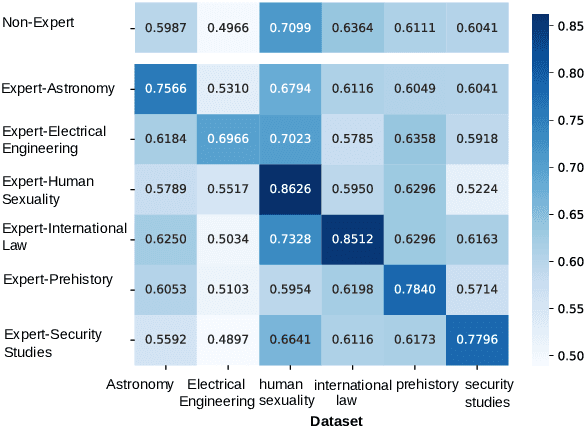

Abstract:We present Expert-Token-Routing, a unified generalist framework that facilitates seamless integration of multiple expert LLMs. Our framework represents expert LLMs as special expert tokens within the vocabulary of a meta LLM. The meta LLM can route to an expert LLM like generating new tokens. Expert-Token-Routing not only supports learning the implicit expertise of expert LLMs from existing instruction dataset but also allows for dynamic extension of new expert LLMs in a plug-and-play manner. It also conceals the detailed collaboration process from the user's perspective, facilitating interaction as though it were a singular LLM. Our framework outperforms various existing multi-LLM collaboration paradigms across benchmarks that incorporate six diverse expert domains, demonstrating effectiveness and robustness in building generalist LLM system via synergizing multiple expert LLMs.
 Add to Chrome
Add to Chrome Add to Firefox
Add to Firefox Add to Edge
Add to Edge